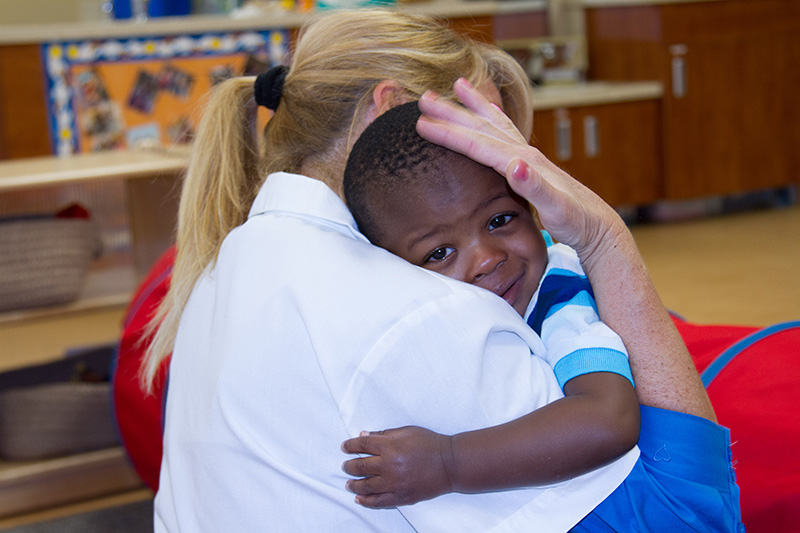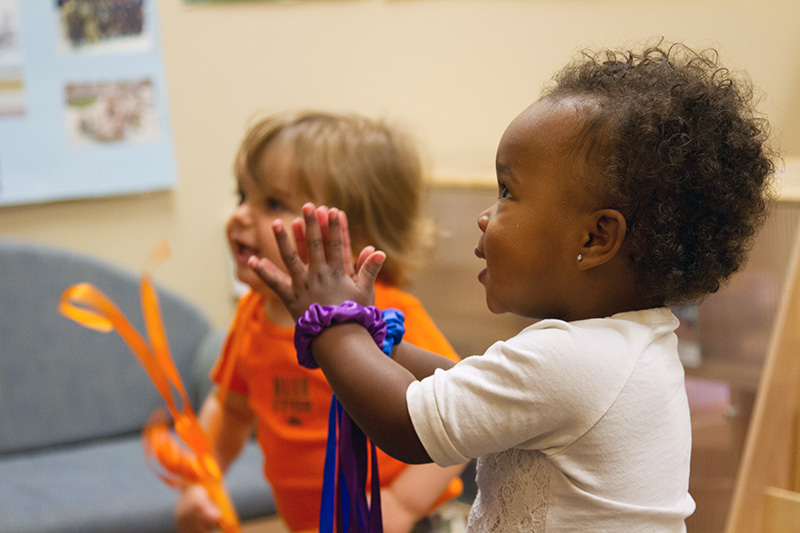重要的是提供各种经验,以支持婴儿和幼儿的社交情绪发展。本课程描述了如何创建促进促进社会情绪发展的互动和经验。
辅助标签
- Identify ideas for providing opportunities to support social-emotional development.
- 探索支持婴儿和幼儿的社会情感发展的策略。
- 支持家庭,因为他们学习的方法promote the social-emotional development of infants and toddlers.
Learn
知道
As an infant and toddler caregiver, you play an important role in each infant’s and toddler’s social-emotional development. As you explored in Lesson Three, the environment impacts the ways infants and toddlers develop and learn new skills. This learning greatly depends on caregivers’ abilities to create responsive and engaging learning opportunities within the environment.
Reflecting on Social-Emotional Development
With the understanding that the environment greatly contributes to infant and toddler learning, reflect on the social-emotional development of the infants and toddlers in your care. Consider your observations, communication with families, and the developmental screening and assessment information you collect. Ask questions about each infant’s and toddler’s development and the interests and discoveries they make. For example:
 婴儿或幼儿是否会去一个主要的照顾者进行舒适?婴儿或幼儿是否允许成年人照顾者帮助他或她在不安时冷静下来?
婴儿或幼儿是否会去一个主要的照顾者进行舒适?婴儿或幼儿是否允许成年人照顾者帮助他或她在不安时冷静下来?- What emotions does the infant or toddler express? In what ways does he or she express emotions?
- 做es the infant or toddler explore the environment with confidence knowing that his or her adult caregiver is nearby?
- 做es the infant or toddler respond to his or her name?
- 婴儿或幼儿如何安慰?
通过询问这些问题,您有机会学习和记录每个婴儿和小孩在您的护理中如何发展社交情感技能。这些问题还可以帮助您考虑其他发展,文化和气质领域。此过程可以帮助您和家庭收集信息,以计划响应环境,因为婴儿和幼儿发展社会情绪化技能,并学习新的方式来传达他们的需求和需求。
支持婴儿和幼儿的社会情感发展
每个婴儿和幼儿以他或她自己的速度发展。社会情绪发展依赖于持续的,敏感关系。除了你在课程中审查的社会情感里程碑之外,婴儿期初会看到个性的基本要素,似乎在整个生命中相当一致。影响个人如何响应世界的元素被称为气质特征。研究人员Alexander Thomas和Stella Chess(1977)编制了与气质相关的特征列表:
 在确定支持社会情感发展的方法和策略时,您应该考虑气质特征,并定制您在每个独特的婴儿和幼儿的方法。您更有可能成功地帮助婴儿和幼儿适应活动和经验,当您变得更加接受气质时促进其社会情感能力。理解和涉及婴儿或幼儿的需求和气质的能力,或照顾者和幼儿之间的关系的质量通常被称为“适合的善良”。就像婴儿和幼儿一样,你对世界的气质风格和一般方法。您的计划中的婴儿和幼儿互动的方式对早期的护理和学习环境产生了强烈影响。狗万app怎么下载仔细考虑气质可以支持适当的活动和经验规划。在探索本课程的部分内,您将有机会反思和了解有关气质的更多信息。
在确定支持社会情感发展的方法和策略时,您应该考虑气质特征,并定制您在每个独特的婴儿和幼儿的方法。您更有可能成功地帮助婴儿和幼儿适应活动和经验,当您变得更加接受气质时促进其社会情感能力。理解和涉及婴儿或幼儿的需求和气质的能力,或照顾者和幼儿之间的关系的质量通常被称为“适合的善良”。就像婴儿和幼儿一样,你对世界的气质风格和一般方法。您的计划中的婴儿和幼儿互动的方式对早期的护理和学习环境产生了强烈影响。狗万app怎么下载仔细考虑气质可以支持适当的活动和经验规划。在探索本课程的部分内,您将有机会反思和了解有关气质的更多信息。
您护理中的一些婴儿和幼儿可能有影响其社交情绪发展的条件。社会情绪发展,在所有阶段,都是一个复杂的过程,涉及其他发展领域,例如认知技能,并通过从环境的意见(家庭,照顾者,同龄人,经验,活动等)增强。例如,一些婴儿和幼儿无法自我抚慰或平静,这可能导致监管障碍的发展。其他婴儿和幼儿可能会遭受抑郁症,特别是如果他们的一个或多个家庭成员沮丧。婴儿和幼儿的抑郁症可以作为饮食或社会互动的宣传,撤回或缺乏兴趣。
Strategy: Learning About Emotions and Emotional Expression
婴儿和幼儿通过与他人的互动来了解情绪和情绪的表达。讨论互动,活动和经验,以及承认和标记情绪,是您可以帮助婴儿和幼儿以健康方式识别,理解和表达情绪的方式。另外,你可以:
- Understand that emotions expressed by infants and toddlers are true feelings seeking responsive care from responsive adults.
- 镜像情感表达 - 如果婴儿或幼儿正在哭泣,你可以在说:“你似乎很沮丧。我要帮助你。“
- 添加单词给面部表情,帮助婴儿和幼儿建立一个情感词汇 - “你微笑;你今天似乎很开心!“
- Use books, music, puppets, and finger plays highlighting emotions and emotional vocabulary.


Strategy: Learning Play and Friendship Skills
婴儿和幼儿正在学习如何与他人互动和玩耍。狗万app怎么下载理解和表达健康方式的情绪可以帮助支持和促进社交技能的发展,包括玩耍,制作和保持朋友,与他人相处。考虑以下想法,以鼓励为您提供婴儿和幼儿的发挥和友谊技巧的发展:
- Place infants next to one another on a blanket on the floor – comment on what you notice the infants doing
- Place a safe mirror low on the wall so that infants can look into the mirror and see themselves and others
- 模型和使用旧幼儿在一起玩时可以使用的单词
- Talk about how infants and toddlers feel to encourage perspective-taking
- Read books about making and playing with friends

See
社会情绪增长的响应互动
做
Responsive and engaging environments are characterized by intentional, frequent use of developmentally appropriate interactions and experiences, including opportunities for social-emotional growth. In your daily interactions with infants and toddlers, consider the following:
 请记住,婴儿和幼儿正在观看您的表达和学习方法来应对强烈的情感 - 使用“i”陈述,并在互动期间描述您的感受。狗万app怎么下载
请记住,婴儿和幼儿正在观看您的表达和学习方法来应对强烈的情感 - 使用“i”陈述,并在互动期间描述您的感受。狗万app怎么下载- Encourage exploration in mobile infants by helping them continue to feel safe: “我看见你!你正在爬行,感到自豪!”
- 经常使用婴儿和幼儿的名称。
- 在自我监管方面思考Tantrums,帮助幼儿重新夺回焦点和关注。
- While reading books to older infants and toddlers, make facial expression that compliments the character or portion of the story: “是的,那头牛感觉很困。让我们睡觉。”
- 通知并描述了女性行为 - “你提供了另一个蓝色的球。你是这么好的朋友。“
- Help young children with peer conflicts — “You both want the truck and are pulling on it. What can we do together to solve this problem?”
Explore
下载并打印社会情感情景讲义。阅读方案并回答问题。想想婴儿和幼儿的独特方式表达情绪和互动,以及如何作为婴儿和幼儿照顾者回应。然后,与培训师,教练或主管分享并讨论您的回复。您还可以查看建议社会情感情景Responses
申请
下载并打印Strategies for Supporting Infant and Toddler Friendship Skills讲义。选择文章中突出的策略之一,以便在您的照顾中使用婴儿或幼儿。观察您的护理中的婴儿和幼儿如何对战略作出反应,并考虑您可能响应支持他们的沟通发展的方式。然后,与培训师,教练或主管分享并讨论您的观察。
Demonstrate
Butterfield,P. M.,Martin,C.,Prairie,A.,&Martin,C. A.(2004)。Emotional connections: How relationships guide early learning。华盛顿特区:零至三。http://eric.ed.gov/?id=ED500098
Gillespie, L. G., & Seibel, N. L. (2006). Self-regulation: A cornerstone of early childhood development.Young Children(61.)4,34-39。
Goleman,D。(2006)社会情报:人际关系的新科学。New York: Bantam Dell.
Petersen,S. H.,&Wittmer,D. S.(2008)。Endless opportunities for infant and toddler curriculum: A relationship-based approach.Upper Saddle River, NJ: Merrill-Prentice Hall.
托马斯,A.&Chess,S.(1977)。气质和发展。纽约:布伦纳 - 米泽。



 婴儿或幼儿是否会去一个主要的照顾者进行舒适?婴儿或幼儿是否允许成年人照顾者帮助他或她在不安时冷静下来?
婴儿或幼儿是否会去一个主要的照顾者进行舒适?婴儿或幼儿是否允许成年人照顾者帮助他或她在不安时冷静下来? 请记住,婴儿和幼儿正在观看您的表达和学习方法来应对强烈的情感 - 使用“i”陈述,并在互动期间描述您的感受。狗万app怎么下载
请记住,婴儿和幼儿正在观看您的表达和学习方法来应对强烈的情感 - 使用“i”陈述,并在互动期间描述您的感受。狗万app怎么下载

